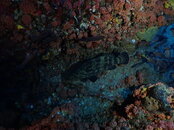From the REEF newsletter, additional information can be found here
www.REEF.org/goliath
Florida Fish and Wildlife Considering Opening Goliath Grouper Harvest
Author
Christy Pattengill-Semmens, Ph.D., Co-Executive Director: Science & Engagement
Growing up to eight feet long and weighing more than 800 pounds, the Goliath Grouper (
Epinephelus itajara) is one of the largest grouper species in the world. Goliath Grouper are considered Critically Endangered by the International Union for the Conservation of Nature (IUCN) and have been protected from harvest in US waters since 1990, after decades of heavy fishing caused a near extinction of the species. The Florida Fish and Wildlife Conservation Commission (FWC) recently asserted that Goliath Grouper population increases have occurred in Florida waters, and therefore some modified take options are warranted. In May 2021, FWC met to consider opening a tag lottery to allow harvest of 100 Goliath Grouper per year for a four-year period. In response to potential changes in protection for the species, researchers from Scripps Institution of Oceanography (SIO) submitted to FWC a summary of an analysis of Goliath Grouper sightings in Florida based on REEF's Volunteer Fish Survey Project data.
Since 1993, REEF's Volunteer Fish Survey Project has leveraged citizen science divers to survey fish abundances through Florida. During this time, divers have conducted tens of thousands of surveys in Florida, collectively adding to a database that represents the best available information relevant to Goliath Grouper populations through time. These data show that Goliath Grouper experienced steady population growth in Florida from exceptionally low levels from the 1990s until 2010. However, over the last decade, this population recovery has either ceased or even reversed. The reason for this recent decline is unclear. Given the apparent reversal in recovery for the species in recent years, any added fishing mortality will almost certainly lead to further population decline. Based on these results, the SIO researchers recommended that the moratorium on harvest for Goliath Grouper be continued.
In advance of the FWC meeting, the commission received more than 3,000 public comments, with 98% favoring a continued ban on harvesting Goliath Grouper. At the end of the discussion at the meeting, the commission members voted 6-1 to take steps toward opening the fishery. They have asked FWC staff to draft a rule, which will be reviewed and voted on in a future meeting.
Because of Goliath's no-take status in Florida and the subsequent lack of traditional fisheries-dependent data, REEF's Volunteer Fish Survey Project has been an invaluable source of information to evaluate the status and trends of Goliath populations over the past few decades. These data have been primarily evaluated and published by Drs. Chris Koenig and Felicia Coleman from Florida State University, and more recently by Dr. Dan Greenberg at SIO.





